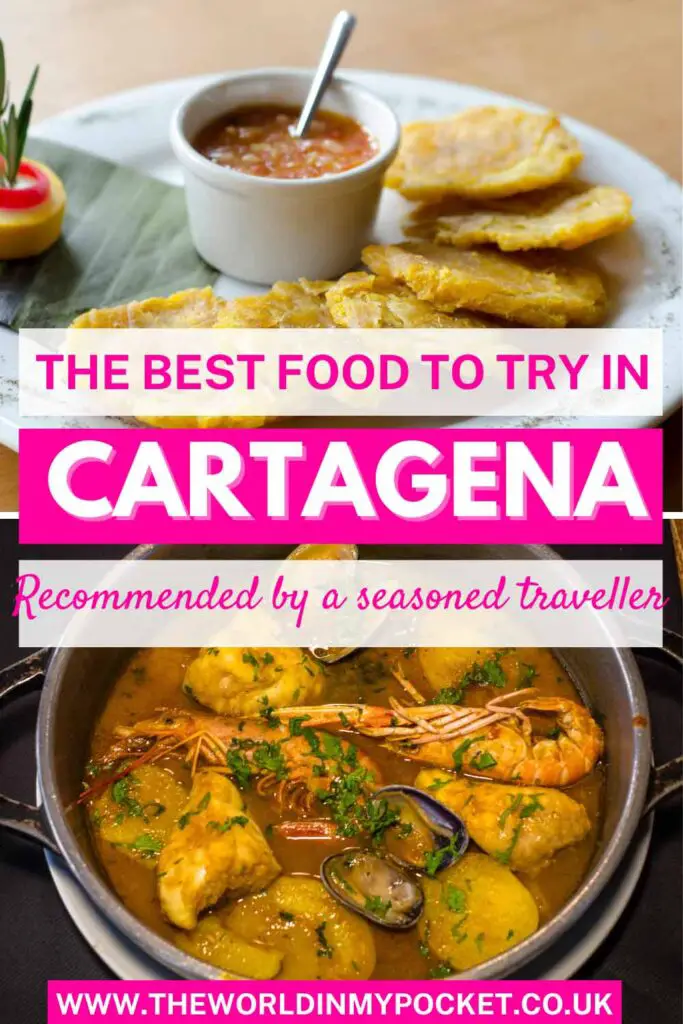Cartagena is Colombia’s Caribbean colonial gem. It’s well known for its charming and colorful architecture, impressive historic city walls and fortifications, and the nearby beautiful beaches and islands.
Learn about some of the best dishes to try during a visit in this guide to what to eat in Cartagena, Colombia.
Cartagena is also increasingly becoming a great foodie destination. There are lots of great Cartagena restaurants that have opened up in recent years. Not to mention, there are lots of great dishes to try with everything from tasty street food, to traditional homemade fare, to fine dining.
What to Eat in Cartagena:
Arepa de Huevo

Colombia’s Caribbean coast has a unique take on the ubiquitous arepa found all over Colombia and elsewhere in Latin America. Almost more akin to an empanada, the arepa de huevo is made from corn meal and filled with an egg and usually ground beef. It’s then fried to crispy, crunchy, golden perfection.
The arepa de huevo can be enjoyed as a breakfast on the go, a late night snack, or anything in between. It’s a favorite in Cartagena, and there is even an annual festival associated with it.
Stands and street stalls around the city sell them, and they are best hot and freshly fried. For some unique variations, the long running Donde Magola serves them filled with chorizo, chicharrón, shredded beef, and even shrimp. If you prefer not to eat meat, don’t worry, you can also order them at most fry stands or Donde Magola with only the egg.
Carimañola
This next food to eat in Cartagena is another fried street food item associated almost exclusively with the Colombian Caribbean. Carimañolas, which derive their name from the Caribbean, are fritters made from yuca, also sometimes called cassava in English.
They are usually filled with cheese or a meat. The best ones will be a bit crunchy on the outside and soft and gooey on the inside. You can find them at many street stalls as well as the aforementioned Donde Magola.
Patacón

The patacón is a popular side dish in many Latin American and Caribbean countries. They are often also called tostones, depending on the country.
They are patties made from a fried piece of plantain, which are then mashed and fried again to a tasty crisp. They are often served with traditional dishes in Cartagena, especially seafood. Some people also enjoy them freshly fried from street stalls with cheese. Others simply enjoy them with a bit of suero, a traditional favorite cream similar to sour cream.
For a unique version of a patacón that makes for a great street food dinner, try a patacón con todo. This is a giant, flat patacón loaded up with meats and cheese. You can find them at stalls around the popular night time hangout spot of the Plaza de la Trinidad.
You will most certainly get some patacones served with the next dish that is an absolute must try in Cartagena!
Traditional Fried Fish Plate

If you’re wondering what to eat in Cartagena while enjoying the nearby gorgeous Rosario Islands or other beaches around Cartagena, look no further than the traditional fried fish plate.
It pairs perfectly with an ice cold beer overlooking the Caribbean!
You’ll usually be served the entire fish, head and tail included, although larger fish may be cut into smaller servings. The best way to eat it is to eat one side entirely first, then flip it over to eat the other side. The most common fish is the mojarra, similar to tilapia, and you can also often get red snapper, or pargo rojo in Spanish.
Arroz de Coco
Your fish plate will likely be served with arroz de coco, or coconut rice. Like the patacón, this is a popular side dish, and you’ll see it served alongside many other dishes as well. It is another must try dish in Cartagena.
There are a number of variations on the recipe, with some being a bit more savory and some a bit sweeter. Some will be white in color, while others will be brown from the use of the unrefined sugar cane known as panela.
Posta Negra

Speaking of panela, it’s also used in this next traditional Cartagena comfort food. In fact, because it’s not often eaten in other parts of Colombia, it’s often referred to as posta negra Cartagenera or simply posta Cartagenera.
Posta negra is sort of a beef roast dish, slow cooked with a sauce made from panela, or sometimes Coca-Cola. It has a sweet, savory taste and pairs very well with coconut rice. While traditionally a working class dish using cheap cuts of beef, many of the nicer restaurants in Cartagena with creative chefs now serve it using higher quality cuts in versions that pay homage to this traditional home cooked meal.
Sancocho de Pescado

We’ve already covered the traditional fried fish plate in this guide to what to eat in Cartagena. The rest of the list will be heavy on seafood. Cartagena is located right on the coast after all, and the seafood is especially tasty and fresh.
Another favorite seafood dish to try in Cartagena is the seafood stew or soup known as sanchocho de pescado. Sancocho is a traditional stew made all over Colombia and often containing other meats such as beef or hen. However, the best one to try in Cartagena is the one featuring pescado.
You may be able to receive some sancocho de pescado as a starter at some stalls serving fried fish on the beach, and some restaurants also serve it as a starter as well.
Cazuela de Mariscos

If you’re a fan of seafood in a soup, the cazuela de mariscos should absolutely be on your list of foods to eat in Cartagena. This seafood stew is another local favorite that is ubiquitous to the Colombian Caribbean coast.
Usually, it contains a variety of seafood and shellfish such as shrimp, calamari, clams, and mussels. Some recipes also use fish and even lobster. They are stewed in a creamy tomato and coconut sauce. It goes absolutely perfectly with some coconut rice and patacones!
Arroz de Mariscos
If you prefer to get your seafood fix with something a little more solid, consider trying an arroz de mariscos, or seafood rice. Usually, these are served containing a mix of different seafood such as fish, shrimp, calamari, and clams.
Different restaurants will serve different variations of this dish. Some may appear yellow in color, while others may be more reddish due to seasoning. Some will be a bit drier. Some will be a bit stickier. Some will be a bit creamier almost like a risotto or paella. Creamier versions may be called arroz melosa. You may also see this dish called arroz a la marinera, and some restaurants may have a shrimp only version, or arroz de camarones.
It’s also quite common to see seafood pastas, called pasta de mariscos or pasta a la marinera served at many Cartagena restaurants. Of course, many restaurants will also serve delicious paellas and risottos as well.
Filete a la Marinera
If you would prefer something a bit easier to manage than a whole fish, most restaurants do serve filets. You can usually get them fried or grilled.
If you’d like to try an especially tasty version of a fish filet, try the filete a la marinera. Your filet will be smothered in a sauce with shellfish like shrimp, clams, and calamari. Typically, this will be in a tomato based sauce somewhat similar to a bisque.
Camarones al Ajillo

Al ajillo is a sauce made from garlic and white wine. Some recipes also use a small amount of cream to thicken it. It is most commonly made with shrimp, or camarones in Spanish. However, it is also delicious with calamari, and some restaurants may even serve a mix of shellfish, fish, and lobster in it. You may even be able to get your fish filet al ajillo.
For those that do not eat fish or shellfish, chicken is also delicious in this sauce.
Ceviche and Seafood Cocktails

It shouldn’t be too surprising that there is terrific ceviche in Cartagena with all the other seafood dishes in this guide to what to eat in Cartagena.
You can also get a tasty shrimp or seafood cocktail. Usually, these are served similar to ceviche with the seafood mixed in with the sauce along with some onions. It isn’t quite like the cocktail sauce from the US and is often more of a mix of ketchup or pink golf sauce and hot sauce.
You can find ceviche served, usually as an appetizer, in most restaurants in Cartagena. Many will have different varieties on offer from traditional ceviche in lime juice, to Peruvian ceviche, to ceviche with a coconut-lime sauce. You can also get traditional ceviche and cocktails at street stalls.
Some particular standouts for ceviche are La Cevichería, made famous after Anthony Bourdain featured it, and La Laguna Azul, a small unassuming place and hidden gem in the Getsemaní district.
Limonada de Coco

Let’s close this guide to what to eat in Cartagena with a few tasty and local favorite things to drink.
First is the limonada de coco, or coconut limeade. They are served at many restaurants and the best ones are thick and creamy. They are especially refreshing on a hot day.
Corozo Juice
You’ll find wonderful, fresh juice all around Colombia, and Cartagena is no exception. Most restaurants will have a handful of fresh juices available. If you’d like to try one that is especially unique to Cartagena, try a corozo juice.
Corozo is a small, tart berry. Since it is very sour, it has be be boiled down to produce the juice. For this reason, it’s not served everywhere since it can be a bit time consuming to make. However, locals consider it a special treat, and many restaurants do serve it. It tastes like a sweet but tart mixture of cranberry and black cherry.
Coco Loco

There are plenty of great and tasty cocktails traditionally associated with the beach and Caribbean worth trying in Cartagena like mojitos, Cuba libres, and piña coladas. You can even get limonada de cocos with alcohol in some places. If you’d like to try a cocktail a little bit less known, you could try a coco loco, or crazy coconut.
These cocktails are almost like a piña colada without the pineapple and are especially tasty on the beach. They are usually served with rum, although some places will also mix in whiskey or even tequila, making it very loco indeed. Some places will even serve it to you in the coconut!
What to Eat in Cartagena Conclusion
Now, you’ve got 15 tasty things to try in Cartagena, 12 foods and 3 drinks. There are plenty of other great foods and drinks in Cartagena, but these stand out for being especially delicious local and traditional favorites that aren’t as easily found elsewhere.
For more similar articles, check out my recommendations below:
Like it? Pin it!

Disclaimer: Some of the links on this website are “affiliate links.” This means that if you click on the link and do a purchase, I will receive an affiliate commission at no extra cost for you. This helps me keep my website running and continue to share my travelling knowledge with you. I thank you for booking your flights or hotels using the links on my website. Regardless, I only recommend products or services I use personally and believe will add value to my readers.

